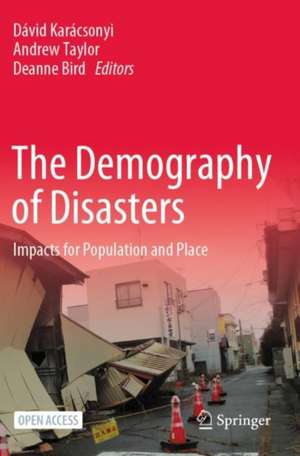The Demography of Disasters: Impacts for Population and Place
Editat de Dávid Karácsonyi, Andrew Taylor, Deanne Birden Limba Engleză Paperback – 19 sep 2021
Both slow onset (like the of loss polar ice from climate change) and sudden disasters (such as cyclones and man-made disasters) have the capacity to fundamentally change the profiles of populations at local and regional levels. Impacts vary according to the type, rapidity and magnitude of the disaster, but also according to the pre-existing population profile and its relationships to the economy and society. In all cases, the key to understanding impacts and avoiding them in the future is to understand the relationships between disasters and population change.
In most chapters in this book we compare and contrast studies from at least twocases and summarize their practical and theoretical lessons.
| Toate formatele și edițiile | Preț | Express |
|---|---|---|
| Paperback (1) | 293.13 lei 38-45 zile | |
| Springer International Publishing – 19 sep 2021 | 293.13 lei 38-45 zile | |
| Hardback (1) | 426.72 lei 3-5 săpt. | |
| Springer International Publishing – 18 sep 2020 | 426.72 lei 3-5 săpt. |
Preț: 293.13 lei
Nou
Puncte Express: 440
Preț estimativ în valută:
56.09€ • 58.56$ • 46.42£
56.09€ • 58.56$ • 46.42£
Carte tipărită la comandă
Livrare economică 31 martie-07 aprilie
Preluare comenzi: 021 569.72.76
Specificații
ISBN-13: 9783030499228
ISBN-10: 3030499227
Pagini: 268
Ilustrații: XVII, 268 p. 42 illus., 36 illus. in color.
Dimensiuni: 155 x 235 mm
Ediția:1st ed. 2021
Editura: Springer International Publishing
Colecția Springer
Locul publicării:Cham, Switzerland
ISBN-10: 3030499227
Pagini: 268
Ilustrații: XVII, 268 p. 42 illus., 36 illus. in color.
Dimensiuni: 155 x 235 mm
Ediția:1st ed. 2021
Editura: Springer International Publishing
Colecția Springer
Locul publicării:Cham, Switzerland
Cuprins
Part 1 People, Vulnerability and Resilience.- Demographic approaches to understanding impacts from disasters.- The four periods of natural and technological disasters.- Demographic and vulnerability aspects of affected populations and regionalization of natural hazards related with extreme rainfall events in Brazil.- Natural Disaster and Social Capital Nexus for Resilience: A study of Jeddah City, Kingdom of Saudi Arabia.- Part 2 – Migration & Relocation, Climate Change and Spatial Impacts.- Relocation of Communities after Natural Disasters in Taiwan and Japan.- Long-term mass displacements after nuclear disasters – Are they the largest emergency displacements of human history?- The demography of Climate change.- Indigenous demographic change and climate change.- Part 3 – Community Life and Recovery.- Communities in Fukushima and Chernobyl – enabling and inhibiting factors for recovery in nuclear disaster areas.- Community Life in the Aftermath of Catastrophe-Caused Demographic Change.- More than time? How Gallivare coped with the 1868 Deprivation and Katherine conceded to the 1998 Cyclone Les.- Indigenous cultural and demographic assets for managing disasters.- Part 4 – Planning for Future.- Planning for population loss.- Lifeline networks: Disruption from disasters or disasters from disruption? OR Reliance, vulnerability and disruption.- Exploring indigenous knowledge for assessing volcanic hazards and improving emergency communication.- Population urbanisation and disaster risks.- Conclusion.
Textul de pe ultima copertă
This open access book provides worldwide examples demonstrating the importance of the interplay between demography and disasters in regions and spatially. It marks an advance in practical and theoretical insights for understanding the role of demography in planning for and mitigating impacts from disasters in developed nations.
Both slow onset (like the of loss polar ice from climate change) and sudden disasters (such as cyclones and man-made disasters) have the capacity to fundamentally change the profiles of populations at local and regional levels. Impacts vary according to the type, rapidity and magnitude of the disaster, but also according to the pre-existing population profile and its relationships to the economy and society. In all cases, the key to understanding impacts and avoiding them in the future is to understand the relationships between disasters and population change.
In most chapters in this book we compare and contrast studies from at least two cases and summarize their practical and theoretical lessons.
Both slow onset (like the of loss polar ice from climate change) and sudden disasters (such as cyclones and man-made disasters) have the capacity to fundamentally change the profiles of populations at local and regional levels. Impacts vary according to the type, rapidity and magnitude of the disaster, but also according to the pre-existing population profile and its relationships to the economy and society. In all cases, the key to understanding impacts and avoiding them in the future is to understand the relationships between disasters and population change.
In most chapters in this book we compare and contrast studies from at least two cases and summarize their practical and theoretical lessons.
Caracteristici
Presents contemporary cross-national studies on population impacts for and from disasters Puts significant focus on climate change With contributions by around 50 international experts Focuses on disasters as caused by human or society vulnerabilities
